Most modern SNA software supports the automated calculation of centrality metrics: once networks are built, analysts need only run the metrics and interpret the results. On each network we ran three common centrality metrics: degree; closeness; and betweenness, defined below (i2, 2010 unless otherwise stated). Just over three years ago, on February 19, 2017, Susan Fowler published a blog post. The company’s handling of the whole thing was an absurdity that, in the context of the rest of Fowler’s blog post, also read as evidence of something more sinister. In one way, 5escortgirls the memoir is an expansion of the 2017 blog post: It documents, in detail that is deeper and more gut-wrenching than a 2,900-word entry could allow, Fowler’s experiences at Uber. It recounts casual sexism and casual racism and, as Maureen Dowd put it in an article about Fowler’s original post, «the self-indulgent, adolescent Pleasure Island mentality of Silicon Valley.» But Whistleblower, despite its subtitle’s reference to Uber, is also a memoir in the classic sense.
This week, Fowler published a book, Whistleblower: My Journey to Silicon Valley and Fight for Justice at Uber. Later, another manager gave Fowler a glowing performance review; he amended it after the fact, she wrote, in order to limit her freedom to move to another team within Uber-and additionally, she speculated, to take credit for keeping a woman as a direct report when relatively few women worked at the company. Before presenting our networks, we should emphasize a few considerations: Results can open up new perspectives and indicate certain solutions may be effective, but they cannot give the definitive ‘right answer’. Ultimately, SNA can support experience and creative problem-solving, but it cannot be a substitute for them. Although we focused on ICST, SNA is useful for any networked crime. Police have enjoyed a long history of mapping connections between actors and commodities involved in crime (Borgatti et al., 2009), particularly organized crime, in line with initiatives such as Organized Crime Group (OCG) mapping. The insights generated by SNA inform ideas for targeted interventions based on the principles of Situational Crime Prevention. Existing data and 5escortgirls software can be exploited in a more systematic and analytical manner to yield new insights.
Results from SNA need not be addressed in isolation, but rather can complement and supplement findings from other sources, in a form of multi-method approach. This database would necessarily be dynamic, so results should be re-evaluated at set intervals to ensure the material remained current. Links include substantial social bonds, e.g. relatives, נערות ליווי ברמת גן נערות ליווי בנתניה נערות ליווי באילת classmates, or neighbours. First, average scores, ranges,2 and standard deviations3 indicate how power is distributed across networks, e.g. when power is evenly shared between members, ranges and standard deviations are usually small. Most offenders scored similarly on closeness, as emphasized by small ranges (6.9 for Operation X; 6.5 for Operation Y) and נערות ליווי בנתניה even smaller standard deviations (2.0 for both). Senior officers might commission networks which go beyond offenders and victims to include critical third parties, about whom very little is currently known. When you loved this informative article and you want to receive much more information concerning נערות ליווי בבת ים generously visit our own internet site. Generally, networks are built with data from on-going investigations and focus on offenders. This work addresses victim networks alongside offender networks. ICST cases are difficult to prosecute, not least because of the huge volume of actors and victim credibility issues. It remains unclear whether ICST clients actively prefer underage girls, or are driven by availability and price considerations. To be of tactical value, networks are best constructed in parallel with live operations, rather than once operations have concluded.
As closeness indicates ready access to co-actors, relatively high averages (32.7 for Operation X; 29.8 for Operation Y) indicate tightly knit networks. These networks which developed independently of and prior to ICST, contrast sharply with ‘typical’ abuse rings formed explicitly around shared interests in child sex abuse (Wortley and Smallbone, 2006). For network members at least, ICST is socially acceptable: awareness campaigns must emphasize its criminality (‘Removing excuses’). A recent study into internal and international child trafficking victims in the UK found that a fifth of all victims were British, the second largest nationality in the sample (CEOP, 2009). Since there is no evidence that British children are trafficked except for sex, these cases probably represent ICST. This article explores the potential of social network analysis as a tool in supporting the investigation of internal child sex trafficking in the UK. Interview data showed that much abuse occurred at parties or other social settings and men often abused en masse. Our interview data showed, for example, that vaginal sex cost approximately £40: well below the market rate for non-trafficked adult prostitutes (Monzini, 2000). If these actors were included in SNA, it would be possible to explore new territory and identify alternative avenues for intervention.
SNA compresses voluminous information to produce concise diagrams and metric scores, but cannot replace the comprehensive understanding of an operation. High scores indicate ability to access other actors independently and quickly transmit/receive information and other commodities. High scores indicate ‘gatekeepers’, who control flows between different parts of the network (Perer and Shneiderman, 2006). As gatekeepers often link otherwise unconnected clusters (Rowley, 1997), their elimination can cause network disintegration. The most central ‘girlfriend’, however, was Operation Y’s e, who was directly connected to 80% of victims. Operation Y’s E and C. Yet SNA found that G and K were the top scorers on all metrics and G was an obvious gatekeeper, scoring several times above average on betweenness. These metrics have two main uses. Second, centrality metrics allow well-connected or influential entities to be identified. Initiatives with care homes might reduce repeat victimization (‘increasing effort’). We discuss below key findings, together with implications for policing and possible interventions.

Comentarios recientes